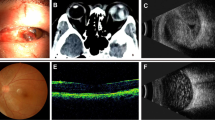Abstract
Purpose
Our purpose was to assess anatomical and functional outcomes of vitrectomy in pediatric cases of Terson syndrome.
Methods
A total of 11 eyes of seven children diagnosed with Terson syndrome secondary to traumatic brain injury and 17 eyes of 12 children diagnosed with Terson syndrome secondary to nontraumatic brain hemorrhage who had 20-gauge or 23-gauge pars plana or pars plicata vitrectomy were included in this retrospective study. The primary outcome was the change in visual acuity from the preoperative examination to postoperative final follow-up. Secondary outcomes were anatomic surgical success and postoperative complications.
Results
The mean time between diagnosis and surgery was 62 ± 35 days (range, 30–150), and the average age at the time of the surgery was 4.5 ± 6.4 years (range, 3 months to 17 years). The mean preoperative logarithm of the minimum angle of resolution (logMAR) (Snellen) best corrected visual acuity (BCVA) was 2.6 ± 0.7 (20/7260) (n = 9) and in the remaining 19 eyes it was recorded as noncentral, unsteady, nonmaintained fixation. The mean follow-up period was 50 ± 54 months (range, 12–192 months). At the last follow-up visit, the mean logMAR BCVA was 0.46 ± 0.6 (20/60) (n = 19) and in eight eyes it was recorded as fix-and-follow. One eye developed a retinal detachment 14 months after the first operation, and one eye developed an epiretinal membrane after 2 years. Anatomical success was recorded in all patients at the final visit.
Conclusions
In children with massive vitreous hemorrhage secondary to Terson syndrome, vitrectomy is an effective procedure and offers a rapid visual improvement. Earlier surgical treatment prevents amblyopia and blood-related potential complications.
Similar content being viewed by others
References
Spirn MJ, Lynn MJ, Hubbard GB (2006) Vitreous hemorrhage in children. Ophthalmology 113(5):848–852
Rishi P, Rishi E, Gupta A, Swaminathan M, Chhablani J (2013) Vitreous hemorrhage in children and adolescents in India. J AAPOS 17(1):64–69
Sudhalkar A, Chhablani J, Jalali S, Mathai A, Pathengay A (2013) Spontaneous vitreous hemorrhage in children. Am J Ophthalmol 156(6):1267–1271
Terson A (1900) De l’hemorrhagie dans le corps vitre au cours de l’hemorrhagie cerebrale. Clin Ophthalmol 6:309–312
Weingeist TA, Goldman EJ, Folk JC, Packer AJ, Ossoinig KC (1986) Terson’s syndrome. Clinicopathologic correlations. Ophthalmology 93(11):1435–1442
Ko F, Knox DL (2010) The ocular pathology of Terson’s syndrome. Ophthalmology 117(7):1423–1429.e2
Czorlich P, Skevas C, Knospe V et al (2015) Terson syndrome in subarachnoid hemorrhage, intracerebral hemorrhage and traumatic brain injury. Neurosurg Rev 38(1):129–136
Manschot WA (1954) Subarachnoid hemorrhage. Intraocular symptoms and their pathogenesis. Am J Ophthalmol 38(4):501–505
Schloff S, Mullaney PB, Armstrong DC et al (2002) Retinal findings in children with intracranial hemorrhage. Ophthalmology 109(8):1472–1476
Capone A (2003) Lens-sparing vitreous surgery for infantile amblyogenic vitreous hemorrhage. Retina 23(6):792–795
Gnanaraj L, Tyagi AK, Cottrell DG et al (2000) Referral delay and ocular surgical outcome in Terson syndrome. Retina 20(4):374–377
Garweg JG, Koerner F (2009) Outcome indicators for vitrectomy in Terson syndrome. Acta Ophthalmol 87(2):222–226
Narayanan R, Taylar SC, Nayaka A et al (2017) Visual outcomes after vitrectomy for Terson syndrome secondary to traumatic brain injury. Ophthalmology 124(1):118–122
Al-Jarallah A, Al-Rifai MT, Riela AR, Roach ES (2000) Nontraumatic brain hemorrhage in children: etiology and presentation. J Child Neurol 15(5):284–289
Maguire SA, Watts PO, Shaw AD et al (2013) Retinal haemorrhages and related findings in abusive and non-abusive head trauma: a systematic review. Eye (Lond) 27(1):28–36
Kuhn F, Morris R, Witherspoon D, Mester V (1998) Terson syndrome. Results of vitrectomy and the significance of vitreous hemorrhage in patients with subarachnoid hemorrhage. Ophthalmology 105(3):472–477
Srinavasan S, Kyle G (2006) Subinternal limiting membrane and subhyaloid haemorrhage in Terson syndrome: the macular ‘double ring’ sign. Eye 20:1099–1101
Schultz PN, Sobol WM, Weingeist TA (1991) Long-term visual outcome in Terson syndrome. Ophthalmology 98(12):1814–1819
Velikay M, Datlinger P, Stolba U, Wedrich A, Binder S, Hausmann N (1994) Retinal detachment with severe proliferative vitreoretinopathy in Terson syndrome. Ophthalmology 101(1):35–37
Author information
Authors and Affiliations
Corresponding author
Ethics declarations
Conflict of interest
All authors certify that they have no affiliations with or involvement in any organization or entity with any financial interest (such as honoraria; educational grants; participation in speakers’ bureaus; membership, employment, consultancies, stock ownership, or other equity interest; and expert testimony or patent-licensing arrangements), or non-financial interest (such as personal or professional relationships, affiliations, knowledge or beliefs) in the subject matter or materials discussed in this manuscript.
Ethical approval
All procedures performed in studies involving human participants were in accordance with the ethical standards of the institutional and/or national research committee and with the 1964 Helsinki Declaration and its later amendments or comparable ethical standards. “For this type of study formal consent is not required.”
Rights and permissions
About this article
Cite this article
Sayman Muslubas, I., Karacorlu, M., Hocaoglu, M. et al. Anatomical and functional outcomes following vitrectomy for dense vitreous hemorrhage related to Terson syndrome in children. Graefes Arch Clin Exp Ophthalmol 256, 503–510 (2018). https://doi.org/10.1007/s00417-017-3887-3
Received:
Revised:
Accepted:
Published:
Issue Date:
DOI: https://doi.org/10.1007/s00417-017-3887-3




